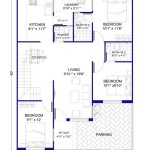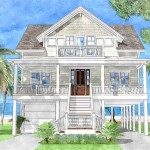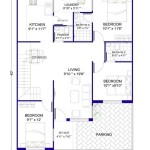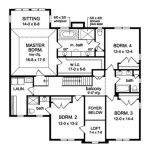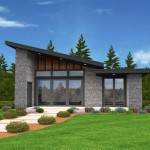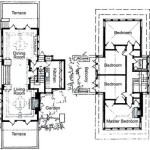U-Shaped House Plans With Courtyard In Middle
The U-shaped house plan, characterized by its distinctive configuration around a central courtyard, represents a compelling architectural concept offering a blend of privacy, natural light, ventilation, and enhanced living experiences. This design strategy has been employed across diverse climates and cultures, adapted to suit various aesthetic preferences and functional requirements. The defining feature of this layout is the enclosed or partially enclosed courtyard, which becomes an integral extension of the interior living space, blurring the boundaries between indoors and outdoors.
The evolution of the U-shaped house plan can be traced back to ancient civilizations, where creating protected and inward-focused spaces was critical for security, climate control, and communal living. Variations of this design have been found in Roman villas, Mediterranean courtyard homes, and traditional dwellings in arid regions. The modern adaptation of the U-shaped house continues to prioritize these fundamental principles while integrating contemporary materials, construction techniques, and lifestyle considerations.
The courtyard, as the focal point of the U-shaped house plan, offers several potential benefits. It can serve as an outdoor living room, a garden, a play area for children, or a tranquil retreat for relaxation. The surrounding structure provides a sense of enclosure and privacy, shielding the courtyard from external noise and views. The open design facilitates natural light penetration into the surrounding rooms, creating bright and airy interiors. Furthermore, the courtyard promotes cross-ventilation, passively cooling the house in warmer climates.
Designing a U-shaped house plan requires careful consideration of several factors, including site orientation, climate, building materials, and the intended use of the courtyard. The orientation of the house is critical for maximizing solar gain in colder climates and minimizing it in warmer climates. The choice of building materials should be appropriate for the local climate and should complement the overall design aesthetic. The size and layout of the courtyard should be carefully considered to ensure it meets the needs of the occupants and enhances the livability of the house.
Key Advantages of U-Shaped House Plans
The U-shaped house plan presents a unique set of advantages that contribute to its appeal as a residential design. These advantages range from practical benefits like improved energy efficiency and natural lighting to more qualitative aspects such as enhanced privacy and aesthetic appeal. Understanding these key advantages is crucial for determining if this architectural style aligns with specific homeowner needs and preferences. This section will detail some primary benefits associated with U-shaped house plans featuring a central courtyard.
One of the most significant advantages of a U-shaped house plan is the enhanced privacy it provides. The design naturally creates a secluded courtyard space, shielded from public view and external disturbances. This is particularly valuable in densely populated areas or on properties where privacy is a primary concern. The U-shaped structure acts as a barrier, creating an intimate and protected outdoor environment that can be enjoyed without external intrusion. This secluded feel is especially beneficial for homeowners seeking a tranquil retreat within their property.
Another significant benefit is the optimization of natural light and ventilation. The open courtyard allows sunlight to penetrate deep into the surrounding rooms, reducing the need for artificial lighting during the day. This natural light enhances the ambiance of the interior spaces, creating a brighter and more inviting atmosphere. Simultaneously, the courtyard facilitates cross-ventilation, allowing air to circulate freely throughout the house. This natural ventilation helps regulate indoor temperatures, reducing reliance on air conditioning and promoting a healthier indoor environment. Proper orientation of the U-shape is crucial to maximize sunlight exposure during the winter and minimize it during the summer, contributing to energy efficiency.
Furthermore, the U-shaped design promotes a strong connection between indoor and outdoor living spaces. The courtyard serves as a seamless extension of the interior, blurring the lines between the two environments. Large windows and doors can be strategically placed to open onto the courtyard, creating a fluid transition between the living areas and the outdoor space. This connection to nature enhances the overall living experience, providing opportunities for relaxation, recreation, and social gatherings in a natural setting. The courtyard can be customized to suit individual preferences, incorporating features such as gardens, patios, pools, and outdoor kitchens.
Design Considerations for Optimal U-Shaped House Plans
While the U-shaped house plan offers numerous benefits, its successful implementation hinges on careful design considerations. These considerations extend beyond the basic layout and encompass factors such as site orientation, climate responsiveness, material selection, and the functional integration of the courtyard. This section will explore key design considerations to ensure that a U-shaped house plan maximizes its potential and meets the specific needs of the occupants.
Site orientation plays a crucial role in the performance of a U-shaped house. The orientation of the house should be optimized to maximize solar gain in colder climates and minimize it in warmer climates. In colder regions, the open side of the U-shape should ideally face south to capture maximum sunlight during the winter months. This passive solar heating can significantly reduce energy consumption for heating. Conversely, in warmer climates, the open side of the U-shape should be oriented away from the direct sun to minimize heat gain. Overhangs and shading devices can further reduce solar heat gain. The prevailing winds should also be considered to optimize natural ventilation through the courtyard and surrounding rooms. Understanding local climate patterns is essential for creating a comfortable and energy-efficient living environment.
Climate responsiveness should be a central theme in the design process. The choice of building materials and construction techniques should be appropriate for the local climate. In hot, arid climates, materials with high thermal mass, such as adobe or concrete, can help regulate indoor temperatures by absorbing heat during the day and releasing it at night. In colder climates, insulation is essential to minimize heat loss. Rainwater harvesting systems can be integrated into the design to conserve water in dry climates. Landscaping choices should also be mindful of the local environment, utilizing native plants that require minimal watering and maintenance. A climate-responsive design creates a sustainable and comfortable living environment that minimizes environmental impact.
The functional integration of the courtyard is paramount. The courtyard should be designed as an extension of the interior living space, seamlessly connecting to the surrounding rooms. The size and layout of the courtyard should be carefully considered to ensure it meets the needs of the occupants. It can be designed as an outdoor living room, a garden, a play area, or a tranquil retreat. Features such as patios, decks, pergolas, and water features can enhance the functionality and aesthetic appeal of the courtyard. The connection between the courtyard and the interior spaces should be emphasized through the use of large windows, doors, and seamless transitions. The courtyard should be easily accessible from multiple rooms to encourage frequent use and create a strong connection between the indoor and outdoor environments. The integration should be carefully planned to ensure both privacy and accessibility are balanced effectively.
Variations and Adaptations of U-Shaped House Plans
The U-shaped house plan, while defined by its basic configuration, lends itself to a remarkable range of variations and adaptations. These adaptations allow the core concept to be tailored to specific site conditions, architectural styles, and lifestyle preferences. The flexibility inherent in the U-shape design enables architects and homeowners to create truly unique and personalized living spaces. This section will explore some common variations and adaptations of the U-shaped house plan.
One common adaptation is the modification of the courtyard enclosure. The courtyard can be fully enclosed by the three arms of the "U," creating a completely private and sheltered space. Alternatively, one side of the "U" can be partially open, allowing for views and access to the surrounding landscape. The degree of enclosure can be adjusted to suit the desired level of privacy and the specific site conditions. For example, a fully enclosed courtyard might be preferred in a densely populated urban area, while a partially open courtyard might be suitable for a rural setting with expansive views. The design should balance the need for privacy with the desire for connection to the surrounding environment.
Another variation involves the use of different materials and architectural styles. The U-shaped house plan can be adapted to a wide range of architectural styles, from traditional to contemporary. It can be constructed from a variety of materials, including wood, brick, stone, concrete, and steel. The choice of materials and architectural style should be appropriate for the local climate and should reflect the aesthetic preferences of the homeowners. For example, a U-shaped house in the Southwest might be constructed from adobe and feature traditional Spanish Colonial design elements, while a U-shaped house in the Pacific Northwest might be constructed from wood and feature modern, minimalist design elements. Regardless of the style chosen, the U-shape can provide an interesting framework for architectural expression.
Furthermore, the U-shaped plan can be adapted to accommodate different site conditions. On sloping sites, the U-shape can be terraced to create multiple levels of outdoor living space. The courtyard can be designed to incorporate existing natural features, such as trees, rocks, and water features. The orientation of the U-shape can be adjusted to maximize views and minimize exposure to adverse weather conditions. The shape of the U can also be adjusted to fit irregular lot shapes or to create specific spatial relationships within the house. The adaptability of the U-shape allows it to be seamlessly integrated into a variety of environments.

2 Bedroom U Shaped Floor Plans With Courtyard Clutterus A Straw House New

U Shaped House Plans With Central Courtyard Google Search Unique Floor Pool

U Shaped House Plans With Courtyard In Middle Google Search Modern

U Shaped House Earthbag Plans Courtyard Houses

U Shaped House Plans Designed By The Architects

Imagini Pentru U Shaped House Plans With Central Courtyard Pool Dream

Contemporary Home Plan 4 Bedrms 3 5 Baths 3278 Sq Ft 137 1347 Courtyard House Plans U Shaped

Central Courtyard Dream Home Plan 81383w Architectural Designs House Plans

U Shaped House Plans With Pool In The Middle Pg2 Architect Designed Various Sizes Houses

Courtyard House Plans U Shaped W The Designers

